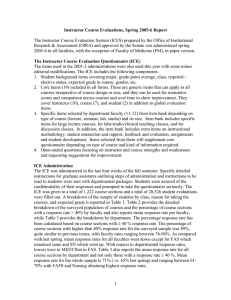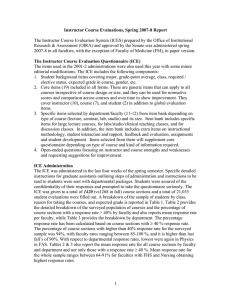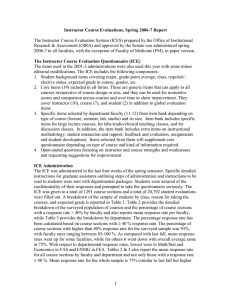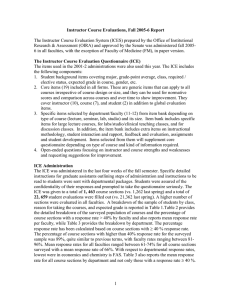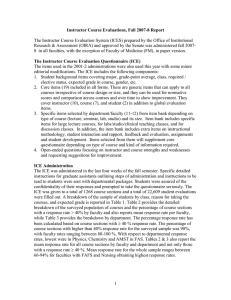The Instructor Course Evaluation System (ICES) prepared by the Office... Research & Assessment (OIRA) and approved by the Senate was... Instructor Course Evaluations, Fall 2003-4 Report
advertisement
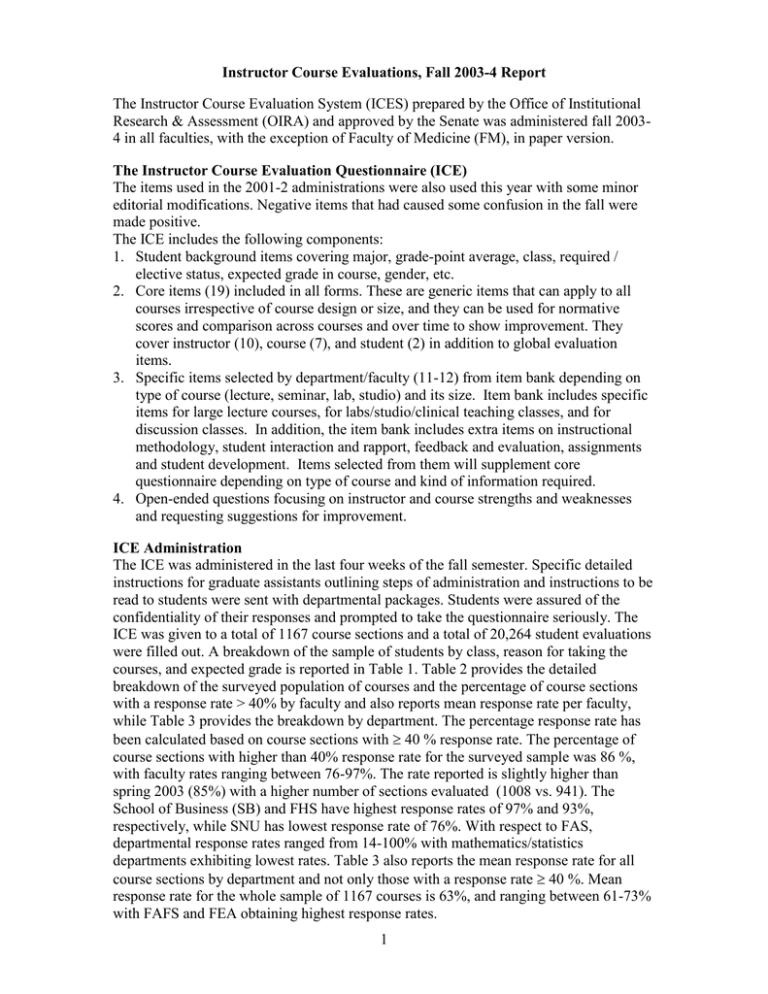
Instructor Course Evaluations, Fall 2003-4 Report The Instructor Course Evaluation System (ICES) prepared by the Office of Institutional Research & Assessment (OIRA) and approved by the Senate was administered fall 20034 in all faculties, with the exception of Faculty of Medicine (FM), in paper version. The Instructor Course Evaluation Questionnaire (ICE) The items used in the 2001-2 administrations were also used this year with some minor editorial modifications. Negative items that had caused some confusion in the fall were made positive. The ICE includes the following components: 1. Student background items covering major, grade-point average, class, required / elective status, expected grade in course, gender, etc. 2. Core items (19) included in all forms. These are generic items that can apply to all courses irrespective of course design or size, and they can be used for normative scores and comparison across courses and over time to show improvement. They cover instructor (10), course (7), and student (2) in addition to global evaluation items. 3. Specific items selected by department/faculty (11-12) from item bank depending on type of course (lecture, seminar, lab, studio) and its size. Item bank includes specific items for large lecture courses, for labs/studio/clinical teaching classes, and for discussion classes. In addition, the item bank includes extra items on instructional methodology, student interaction and rapport, feedback and evaluation, assignments and student development. Items selected from them will supplement core questionnaire depending on type of course and kind of information required. 4. Open-ended questions focusing on instructor and course strengths and weaknesses and requesting suggestions for improvement. ICE Administration The ICE was administered in the last four weeks of the fall semester. Specific detailed instructions for graduate assistants outlining steps of administration and instructions to be read to students were sent with departmental packages. Students were assured of the confidentiality of their responses and prompted to take the questionnaire seriously. The ICE was given to a total of 1167 course sections and a total of 20,264 student evaluations were filled out. A breakdown of the sample of students by class, reason for taking the courses, and expected grade is reported in Table 1. Table 2 provides the detailed breakdown of the surveyed population of courses and the percentage of course sections with a response rate > 40% by faculty and also reports mean response rate per faculty, while Table 3 provides the breakdown by department. The percentage response rate has been calculated based on course sections with 40 % response rate. The percentage of course sections with higher than 40% response rate for the surveyed sample was 86 %, with faculty rates ranging between 76-97%. The rate reported is slightly higher than spring 2003 (85%) with a higher number of sections evaluated (1008 vs. 941). The School of Business (SB) and FHS have highest response rates of 97% and 93%, respectively, while SNU has lowest response rate of 76%. With respect to FAS, departmental response rates ranged from 14-100% with mathematics/statistics departments exhibiting lowest rates. Table 3 also reports the mean response rate for all course sections by department and not only those with a response rate 40 %. Mean response rate for the whole sample of 1167 courses is 63%, and ranging between 61-73% with FAFS and FEA obtaining highest response rates. 1 Table 1.ICE (Fall 2003-4) Sample Description Class Freshman Sophomore Junior Senior 4rth Year Graduate Special Valid % 6 30 25 22 5 7 1 Reason for taking Course Required from major Elective from major Elective outside major Required outside major University required Valid % 57 11 11 10 7 Expected Grade 90 85-89 80-84 70-79 70 Valid % 13 23 27 27 6 Table2: Surveyed Population of Courses & Response Rates by Faculty Courses Response Rate >=40 % >=40 Mean Resp. Rate Agricultural & Food Sciences 37 37 100% 73% Arts & Sciences 690 580 84% 62% Business 159 154 97% 61% Engineering & Architecture 194 161 83% 72% Health Sciences 58 54 93% 64% 29 1167 22 1008 76% 86% 65% 63% Faculty Nursing Total AUB Table 3: Response Rates & Courses Surveyed by Department Faculty Agricultural & Food Sciences Dept. AGRL Count of Course 4 2 >=0.4 4 % >=0.4 100% Mean Resp Rate 78% Faculty Agricultural & Food Sciences Agricultural & Food Sciences Agricultural & Food Sciences Agricultural & Food Sciences Arts & Sciences Arts & Sciences Arts & Sciences Arts & Sciences Arts & Sciences Arts & Sciences Arts & Sciences Arts & Sciences Arts & Sciences Arts & Sciences Arts & Sciences Arts & Sciences Arts & Sciences Arts & Sciences Arts & Sciences Arts & Sciences Arts & Sciences Arts & Sciences Arts & Sciences Business Business Business Business Business Business Business Business Engineering & Architecture Engineering & Architecture Engineering & Architecture Engineering & Architecture Engineering & Architecture Engineering & Architecture Engineering & Architecture Engineering & Architecture Engineering & Architecture Engineering & Architecture Engineering & Architecture Health Sciences Health Sciences Health Sciences Health Sciences Dept. ANSC LWRS NFSC PLSC ARAB AROL BIOL CHEM CMPS CVSP ECON EDUC ENGL FREN GEOL HIST MATH MEST PHIL PHYS PSPA SBHS STAT ACCT BUSS ENTP FINA FOLC MKTG MNGT OPIM ARCH ASST CIVE CVEV EECE ENMG ENSC GRDS MCEG MECH URPL ENHL EPHD HBED HMPD Count of Course 6 5 17 5 26 4 54 23 40 84 39 40 114 3 15 11 83 1 17 40 44 45 7 26 18 1 26 4 22 30 32 30 7 13 8 64 13 5 24 3 23 4 8 14 7 7 3 >=0.4 6 5 17 5 26 4 45 20 35 78 32 39 110 3 14 11 34 0 16 26 43 43 1 26 17 1 25 4 21 30 30 27 6 9 6 57 8 5 22 0 17 4 8 12 7 7 % >=0.4 100% 100% 100% 100% 100% 100% 83% 87% 88% 93% 82% 98% 96% 100% 93% 100% 41% 0% 94% 65% 98% 96% 14% 100% 94% 100% 96% 100% 95% 100% 94% 90% 86% 69% 75% 89% 62% 100% 92% 0% 74% 100% 100% 86% 100% 100% Mean Resp Rate 76% 76% 65% 88% 72% 66% 61% 60% 57% 69% 56% 71% 73% 76% 66% 66% 38% 27% 60% 53% 68% 64% 27% 62% 64% 66% 68% 74% 59% 71% 63% 61% 72% 62% 61% 67% 42% 78% 57% 24% 55% 78% 76% 66% 73% 72% Faculty Health Sciences Health Sciences Health Sciences Nursing Dept. LABM MLTP PBHL NURS Count of Course 10 5 7 29 >=0.4 9 5 6 22 % >=0.4 90% 100% 86% 76% Mean Resp Rate 78% 88% 54% 64% Results Reliability analysis conducted on the scale revealed very high reliabilities of r=. 96 for the whole scale (n=19), r=. 94 for instructor effectiveness subscale (n=10), r=. 90 for the course effectiveness subscale (n=7), and r=. 86 for learning outcomes subscale (n= 2). These reliabilities are quite similar to those obtained on previous administrations, and they confirm the internal stability and consistency of the ICE as measuring one main trait, teaching effectiveness and with consistency. Results were reported to each faculty member, department chair, and dean electronically. As for the comments, they were sent in sealed envelopes to the respective deans’ offices. In addition to item means, averages/percentiles were reported for the instructor, the course and for student learning outcome development. In addition, category, faculty, and university percentiles/means were reported for each item and for each subgroup. Percentiles were computed using only course sections with equal to or more than 40% response rates. In addition, three additional reports were provided to the deans: one summarizing institutional performance on 19 core items by faculty, another providing summary data for all departments within their faculty, and a third providing a summary for each department in the faculty. Department chairs also got a copy of their department summary. Figures 1 and 2 present summary normative data for ICE subscales per faculty and for the University for fall 2003, and in comparison with fall 2002-03 and spring 2003. Only course sections with response rate equal or higher than 40% were included in normative data as they provide more reliable estimates. As in previous administrations, students’ evaluations of teachers were, in general, higher than their evaluations of courses and of learning outcomes. Fall 2003 ICE results higher than those for past fall terms on three subscales and quite close to spring results for each of instructor (mean=4.1), course (mean=3.8) and learning outcomes (mean=3.9). Figure 1: AUB average per subscale, fall & spring 2002/3 and fall 2003 4 4.2 4.1 4.1 4.1 4 4 3.9 3.9 3.9 3.9 3.8 Fall 2002/3 Spring 2002/3 3.8 3.8 Fall 2003/4 3.7 3.7 3.6 3.5 Instructor Teaching Effectiveness Course Evaluation Learning Outcomes Figure 2: Average score per faculty, fall & spring 2002/3 and fall 2003 Instructor Teaching Effectiveness Items 1-10 4.6 4.4 4.2 4.3 4.1 4.1 4.1 4.1 4.14.1 4 4.14.1 4.14.1 4 4 3.9 3.9 3.9 Spring 2002/3 Fall 2003/4 3.8 3.8 Fall 2002/3 3.7 3.6 3.4 AG AS EA HS NU SB With respect to instructor effectiveness, mean scores ranged between 3.9-4.1 this fall as compared to 3.8-4.3 last spring and 4.1-4.5 last fall. Faculties’ means are getting closer to each other, and most of them, except for FEA and SNU, got a mean score of 4.1 Nearly all means were higher than last fall, except for SNU and FAFS, and were similar to spring 2003 results. Course Evaluation Items 11-17 5 4.6 4.4 4.2 4.1 4 3.9 3.9 3.8 Fall 2002/3 4 4 3.93.9 3.9 3.93.9 3.8 3.8 3.8 3.73.7 3.6 Spring 2002/3 Fall 2003/4 3.8 3.7 3.5 3.4 AG AS EA HS NU SB With respect to course evaluations, they ranged between 3.7-4.0 as compared with 3.74.1 last spring and 3.5-3.9 last fall. These results confirm the previous finding that this fall results are higher than last fall and are quite close to last spring. Most of the faculties averaged 3.9. Learning Outcomes Items 18-19 4.6 4.4 4.3 4.2 4.2 4.1 4.1 4 4 3.9 3.9 3.8 3.9 3.8 3.8 3.8 4 4 Fall 2002/3 Spring 2002/3 3.93.9 3.8 3.8 Fall 2003/4 3.7 3.6 3.4 AG AS EA HS NU SB As to learning outcomes, scores ranged between 3.8-4.1, as compared to 3.8-4.3 last spring and 3.7-3.9 last fall. Most faculties improved over last fall, were same (FHS, SB) or slightly lower ( FAS, SNU) than last spring. FEA means were higher than spring term results. Additional Items Items 20 onward 6 4.6 4.4 4.2 4.1 4 4 4 4 Fall 2003/4 3.9 3.8 3.7 3.6 3.4 AG AS EA HS NU SB Additional items means ranged between 3.7-4.1 with most faculties averaging 4.0 on these items. As to item # 10, overall effectiveness of instructor, it averaged 3.9 for all faculties and was same as last fall and spring averages. Also, item # 17, overall course effectiveness, averaged 3.7 slightly less than spring (3.8) but similar to fall of 2002-3. A breakdown of items 10 and 17 averages by faculty is reported in Table 4. Table 4: Average of Overall Items by Faculty Faculty N Item # 10 Item # 17 37 580 161 54 22 154 1008 3.9 3.7 3.6 3.7 3.8 3.8 3.7 FAFS FAS FEA FHS SNU SB AUB Average 4.0 4.0 3.7 3.9 3.9 4.0 3.9 Appendix presents item statistics for the 19 core items by department, faculty, and for the whole university. 7 Table 5 presents subscale averages and their relevant quartiles per faculty and for the university. Table 5: Subscale Averages& Quartiles per Faculty& for University N Mean Percentiles Valid Course Evaluation Instructor Teaching Effectiveness Learning Outcomes AG AS EA HS NU SB AUB 37 580 161 54 22 154 1008 4.1 4.1 3.9 4.1 3.9 4.1 4.1 25 3.9 3.9 3.5 3.7 3.7 3.9 3.8 AG AS EA HS NU SB AUB AG AS EA HS NU SB AUB 37 580 161 54 22 154 1008 37 580 161 54 22 154 1008 4.0 3.9 3.7 3.9 3.8 3.9 3.8 4.1 3.8 3.9 3.9 4.0 4.0 3.9 3.7 3.6 3.4 3.6 3.5 3.7 3.6 3.8 3.5 3.6 3.6 3.7 3.7 3.5 50 4.2 4.1 3.9 4.2 4.0 4.2 4.1 75 4.4 4.4 4.3 4.4 4.3 4.3 4.4 4.0 3.9 3.8 3.9 3.9 4.0 3.9 4.3 3.9 3.9 4.0 4.2 4.0 3.9 4.4 4.1 4.0 4.2 4.2 4.2 4.1 4.5 4.2 4.3 4.4 4.4 4.3 4.3 Table 6 presents subscale means by category of courses in every faculty. Lowest and highest categories within each faculty were highlighted to facilitate comparison for improvement. Table 6: Subscale Means Per Category Per Faculty Faculty CATEGORY COUNT 8 A B C AG AG AG AG AG Graduate Lecture Lab Teaching Large Lecture Lecture + Lab Small Lecture 8 4 11 3 11 4.3 4.1 4.0 4.2 4.1 4.0 3.9 3.9 4.0 4.1 4.2 4.2 4.1 4.2 4.0 AS AS AS AS AS Education-Method Education-Non-Method Humanities Sciences Social Sciences 9 30 248 175 118 4.4 4.1 4.1 4.0 4.2 4.1 3.8 3.9 3.7 4.0 4.4 3.9 3.8 3.7 4.1 EA EA EA EA EA EA EA AI Discussion Lecture + Assignmt. EI EII III IV Small Lecture 17 1 83 19 29 9 3 4.0 4.1 4.0 3.5 3.7 4.0 4.0 3.8 3.4 3.8 3.4 3.6 3.9 4.0 3.9 4.4 3.9 3.4 3.9 4.2 4.0 HS HS HS HS HS HS NU Discussion Lecture Discussion Lecture + Assign Lecture Lecture + Assignment Lecture + Computer Lab Lecture + Lab SNU 9 15 16 11 1 2 22 4.3 3.9 4.1 4.1 4.1 4.4 3.9 4.1 3.9 3.8 3.9 3.5 4.0 3.8 4.2 3.8 4.0 3.8 3.9 4.0 4.0 SB SB SB SB SB SB SB ACCT BUSS ENTP FINA MKTG MNGT OPIM 26 21 1 25 21 30 30 4.0 4.1 4.0 4.2 4.3 4.1 3.9 3.8 3.9 4.2 3.9 4.2 4.0 3.7 3.9 4.0 4.1 4.2 4.4 4.0 3.5 Conclusion: Accomplishments and Areas of Improvement The fall administration went smoothly as we have become more organized and were able to anticipate problems ahead of time. Forms were sent early, first week of December, to provide departments with ample time to do the administration and not to have to leave it till last two weeks of term when attendance is usually low. Before we prepared the forms and sent them, we made sure that course/instructor/section coordinates were accurate and reflected what actually is and not what is supposed to be according to the Banner. Proper coding was given to large lectures, lab lectures, multi-instructor courses, etc. Before scanning the filled out forms, OIRA staff checked the course/section/department/faculty information entered by students. These procedures decreased the problems encountered in data entry and enabled the issuing of the results in final form within two weeks period instead of the usual one month. Reports generated followed format adopted last fall and faculty members were provided with an interpretive guide. In addition, summary 9 institutional, faculty, and departmental reports were issued to deans and department chairs. These summary reports were also published on OIRA website for possible review by faculty and students, and this step provided evidence that the evaluations are taken seriously by faculty and by the administration. Procedures to produce the ICE reports were improved through automating most of the stages of the process and the report production. Also, present setup allows for build up of a database, and future plans entail, customizing a trends report by teacher, course or department and/or by item. Despite the above accomplishments, several problems were encountered that we hope can be overcome in future administrations: 1. The main problem still seems to be getting up-to-date accurate information regarding courses/sections offered and their enrollment. Although we have resorted lately to obtaining our information from departments or deans’ offices directly, these also are not always updated enough, especially with regard to enrollment. We got course capacity information and not actual enrollment information in many cases which affected response rate obtained. 2. Departments need to inform dean’s office with changes they had incorporated and these should be reflected on Banner. Similarly, deans’ offices should alert us to courses with labs and lectures with different instructors, and to courses being taught by more than one instructor. 3. Administration procedures should improve. Graduate assistants should be trained on how to administer the ICE and how to motivate students to answer. They should be given adequate time to conduct the evaluations and not to leave everything to the last week of the semester or to conduct them during final exams. They should seal the envelopes of every administration and send it back to OIRA tidily and not in a mess (all mixed up, information not properly filled in, wrong coding, etc.) 10
